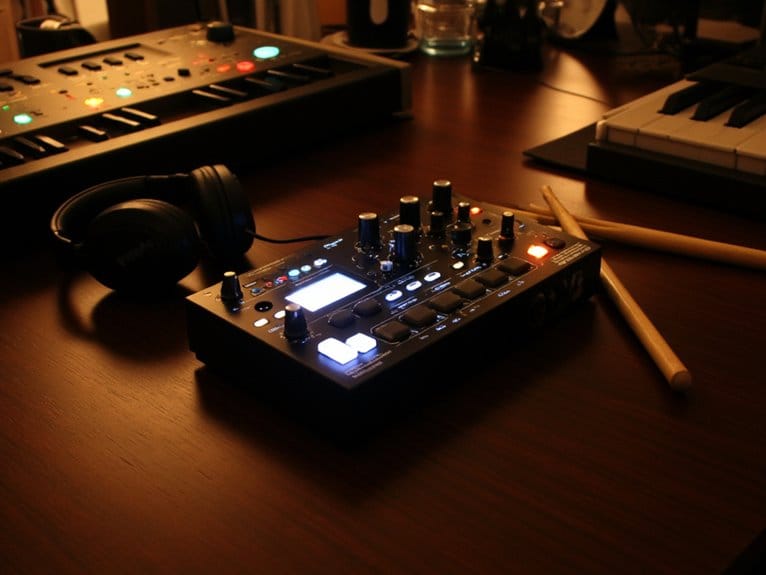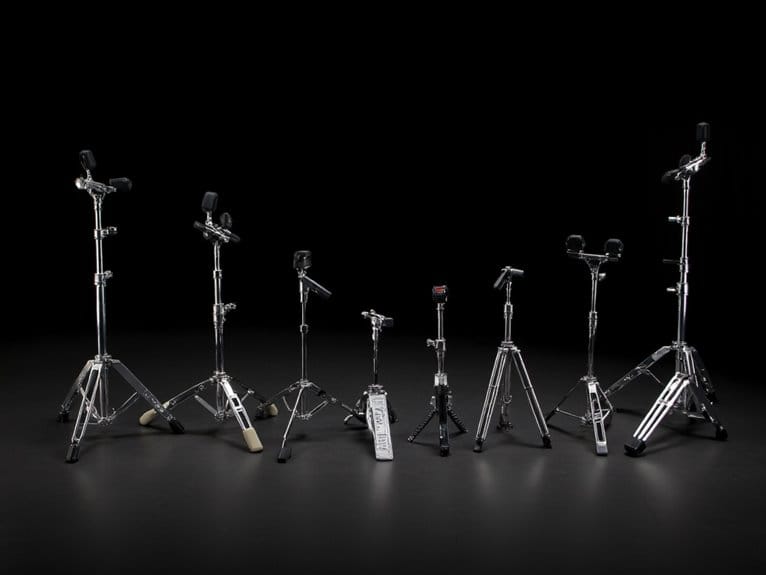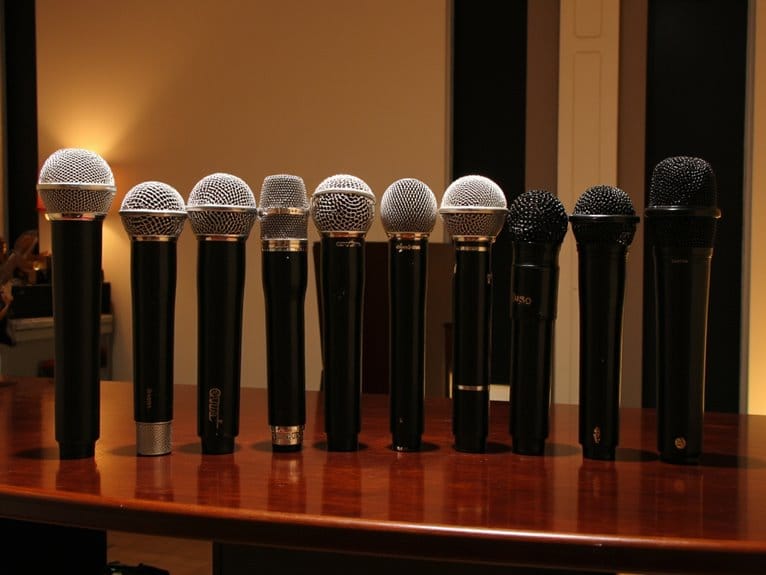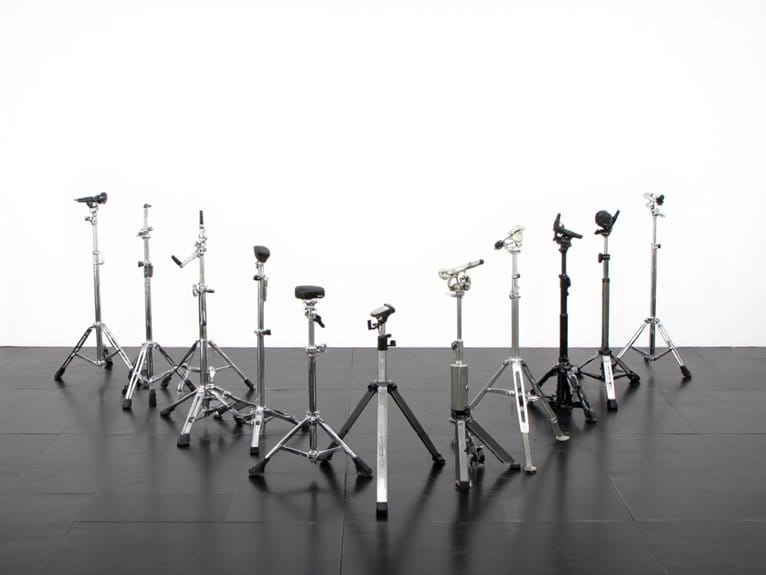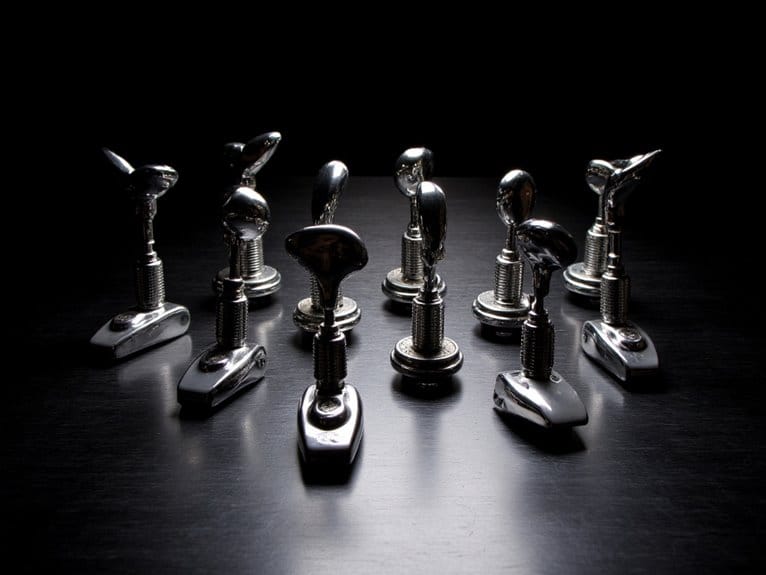Best Drum Modules – Studio-Quality Sound for Every Drummer
I’ve tested dozens of drum modules, and the standout performers include Roland’s TD-27 with Prismatic Sound Modeling for realistic acoustic simulation, the versatile TD-07 offering 25 preset kits with Bluetooth connectivity, and Elektron’s Digitakt II featuring 16-track sequencing capabilities. The KAT KTMP1 delivers four velocity-sensitive zones for compact setups, while Yamaha’s EAD10 bridges acoustic and electronic worlds with studio-quality effects. Each module serves different needs, from apartment-friendly practice to professional recording, and understanding their specific strengths will help you make the perfect choice for your drumming goals.
We are supported by our audience. When you purchase through links on our site, we may earn an affiliate commission, at no extra cost for you. Learn more.
Notable Insights
- Roland TD-27 delivers studio-quality sound with Prismatic Sound Modeling and PureAcoustic Ambience Technology for authentic acoustic drum simulation.
- Elektron Digitakt II offers professional producers a 16-track drum computer with 128-step sequencer and hands-on control capabilities.
- Roland VQD106 V-Drums provides complete 5-piece setup with 75% noise reduction, perfect for apartment drummers needing studio-quality sound.
- Advanced connectivity features like USB, Bluetooth, and multi-channel recording outputs enable seamless integration with modern studio workflows.
- Velocity-sensitive pads and dynamic articulation technology across top modules ensure accurate capture of playing nuances and expression.
Elektron Digitakt II 16-Track Drum Computer and Sampler
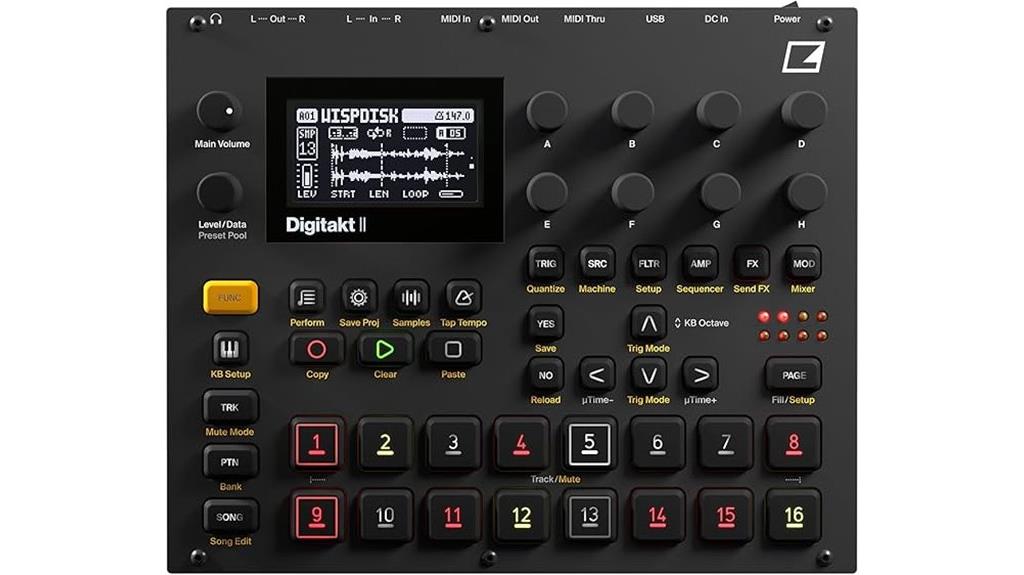
Swedish engineering meets modern sampling in the Elektron Digitakt II, a 16-track drum computer that’s built for producers who crave hands-on control and don’t mind investing time to master its unique workflow. You’ll appreciate the cast aluminum construction and intuitive OLED display, though I’ll warn you that the learning curve demands patience and forum diving. The 128-step sequencer, three assignable LFOs per track, and per-track effects like delay and reverb create complex grooves that shine in live performance settings. While sample loading feels cumbersome initially and DAW integration remains limited, the analog-like sound quality and engaging hands-on experience make this Swedish powerhouse worth the investment.
Best For: Producers who enjoy hands-on, DAW-less production and are willing to invest time learning a unique workflow for live performance and sample-based music creation.
Pros:
- Exceptional build quality with cast aluminum construction and intuitive OLED display that feels professional and robust
- Powerful sequencing capabilities with 128-step sequencer, 3 LFOs per track, and comprehensive per-track effects for creating complex grooves
- Analog-like sound quality and engaging hands-on workflow that excels in live performance settings
Cons:
- Steep learning curve that requires substantial time investment and community forum research to master
- Cumbersome initial sample loading process and unique terminology that may confuse users familiar with other samplers
- Limited DAW integration support, making it less suitable for producers who rely heavily on computer-based workflows
Roland V-Drums TD-27 Electronic Drums Sound Module
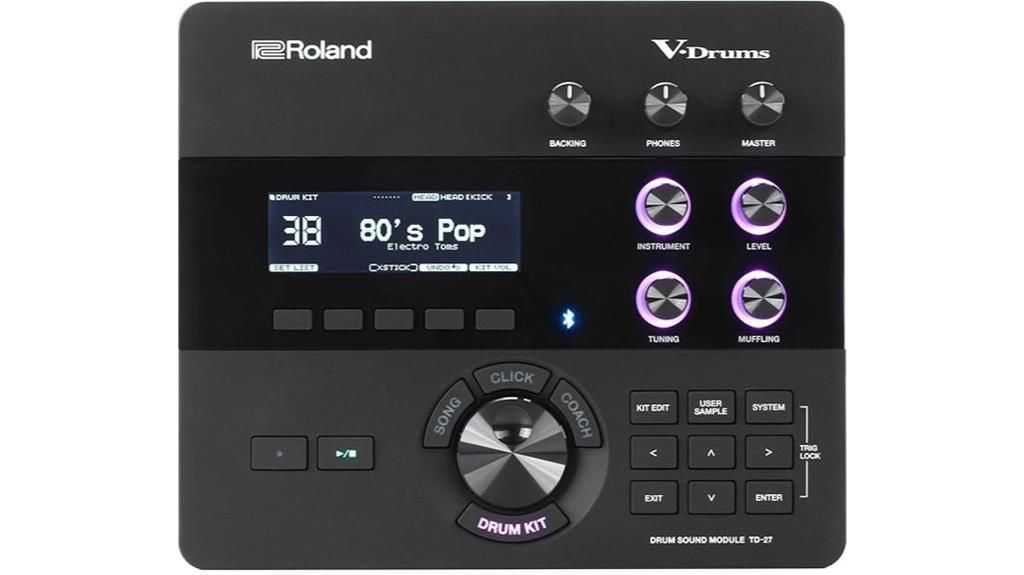
Prismatic Sound Modeling combined with PureAcoustic Ambience Technology makes the Roland V-Drums TD-27 Electronic Drums Sound Module a compelling choice for drummers who prioritize realistic acoustic drum sounds over flashy preset collections. You’ll appreciate the extensive kit customization options, which let you adjust dampening, tuning, and sizing parameters to match your performance needs. The individual channel recording capability proves invaluable for studio work, while the built-in V-drums map simplifies Logic integration. However, you should consider that the proprietary dongle cable represents a potential weak point, and the two-bolt mounting system feels less secure than traditional four-bolt designs that most professionals expect.
Best For: Drummers who prioritize realistic acoustic drum sounds and need extensive customization options for studio recording and live performance applications.
Pros:
- Prismatic Sound Modeling and PureAcoustic Ambience Technology deliver exceptionally natural-sounding drum samples
- Individual channel recording capability and excellent routing options make it ideal for studio work and live sound separation
- Extensive kit customization with adjustable dampening, tuning, and sizing parameters plus built-in Logic integration
Cons:
- Proprietary dongle cable creates a potential failure point and costly replacement concern
- Two-bolt mounting system feels less secure than the four-bolt designs preferred by professionals
- Emulated sounds may require EQ adjustments to avoid flat-sounding output
Roland TD-07 V-Drum Module with Cable Snake Bundle
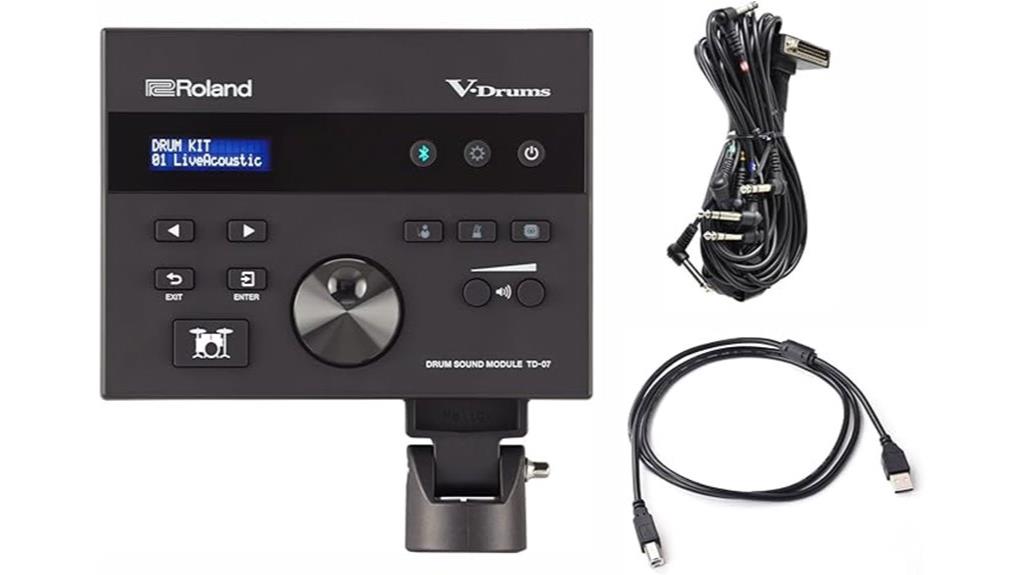
When you’re searching for a drum module that balances professional features with beginner-friendly accessibility, the Roland TD-07 V-Drum Module with Cable Snake Bundle emerges as a compelling choice that won’t overwhelm newcomers while still satisfying experienced players. You’ll find 25 preset kits alongside 25 user kits, giving you 143 instruments to explore authentic drum sounds through Roland’s advanced V-Drums technology. The module includes V-Edit capabilities, EQ controls, ambience settings, and 30 multi-effects for extensive sound customization, while integrated Bluetooth enables wireless audio streaming and MIDI transmission for modern connectivity needs.
Best For: Beginner to intermediate drummers who want professional-quality sound features with user-friendly accessibility, plus the convenience of wireless connectivity and comprehensive learning tools.
Pros:
- Extensive sound library with 50 total kits and 143 instruments, plus advanced V-Drums technology for authentic acoustic drum behavior
- Comprehensive connectivity options including Bluetooth, USB audio/MIDI interface, and plug-and-play DAW integration
- Built-in learning features with interactive coach function, onboard metronome, and 40 free Melodics lessons
Cons:
- May be too feature-rich and complex for absolute beginners who just want basic drumming functionality
- Unlimited Melodics lessons require additional subscription cost beyond the included 40 free lessons
- Cable snake bundle suggests multiple connection requirements that could complicate initial setup
Alesis Surge Drum Module with Cable Snake and Silverline Audio Cable Bundle
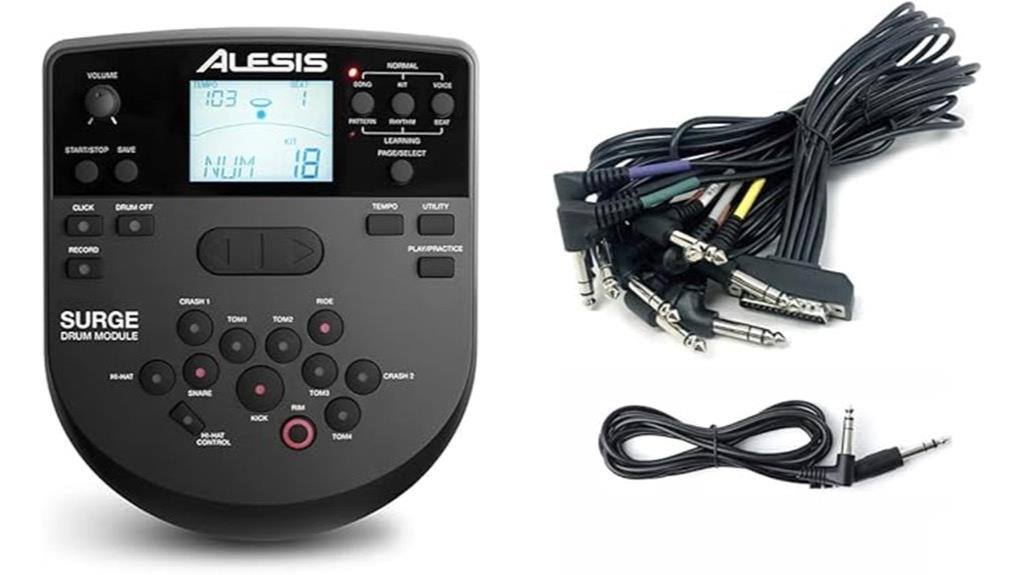
Musicians seeking an all-encompassing electronic drumming solution that bridges the gap between beginner accessibility and professional functionality will find exceptional value in the Alesis Surge Drum Module with Cable Snake and Silverline Audio Cable Bundle. You’ll get 40 complete drum kits—24 presets plus 16 customizable options—alongside 385 authentic drum and percussion sounds that’ll satisfy your creative demands. The included 60 play-along tracks, combined with the integrated sequencer, metronome, and performance recorder, transform practice sessions into productive experiences. USB/MIDI connectivity supports virtual instruments and recording software, while the CD/MP3 auxiliary input lets you jam with personal tracks seamlessly.
Best For: Musicians who want a versatile electronic drum module that offers both beginner-friendly features and professional recording capabilities for practice, performance, and studio work.
Pros:
- Extensive sound library with 385 drum and percussion sounds across 40 kits (24 preset + 16 customizable)
- Comprehensive connectivity including USB/MIDI for recording software and aux input for playing along with personal music
- Built-in practice tools like 60 play-along tracks, sequencer, metronome, and performance recorder enhance learning and creativity
Cons:
- May have a learning curve for beginners unfamiliar with electronic drum modules and their various settings
- Sound quality and realism may not match higher-end professional drum modules in the same price range
- Limited information provided about the build quality and durability of the included cable snake and accessories
Yamaha EAD10 Electronic-Acoustic Drum Module with Stereo Microphone and Trigger

Hybrid drumming enthusiasts who’ve been waiting for a seamless bridge between acoustic authenticity and electronic versatility will find their answer in the Yamaha EAD10, a module that transforms any traditional drum kit into a digital powerhouse without sacrificing the organic feel they love. You’ll appreciate the five-minute setup process that delivers 50 preset scenes, 200 user customization options, and studio-quality digital effects through its integrated stereo microphone system. The companion iOS app handles tempo detection, click tracks, and video uploads seamlessly, while the module’s trigger connectivity expands your sonic palette beyond traditional acoustic boundaries for enhanced live performance presence.
Best For: Drummers of all skill levels who want to enhance their acoustic drum kit with electronic capabilities for recording, practice, and live performance without losing the natural feel of acoustic drums.
Pros:
- Quick 5-minute setup with extensive customization options including 50 presets and 200 user scenes
- Free iOS app provides comprehensive features like tempo detection, click tracks, and video upload capabilities
- Studio-quality digital effects and trigger connectivity expand sonic possibilities while maintaining acoustic authenticity
Cons:
- Kick drum trigger sensitivity issues reported by some users affecting performance reliability
- Additional equipment purchases often needed including cables, triggers, and mounting hardware to optimize setup
- Potential static issues from cable connections and setup complexity when integrating with other audio equipment
Alesis Sample Pad 4 Compact Percussion Instrument with 4 Velocity Sensitive Pads
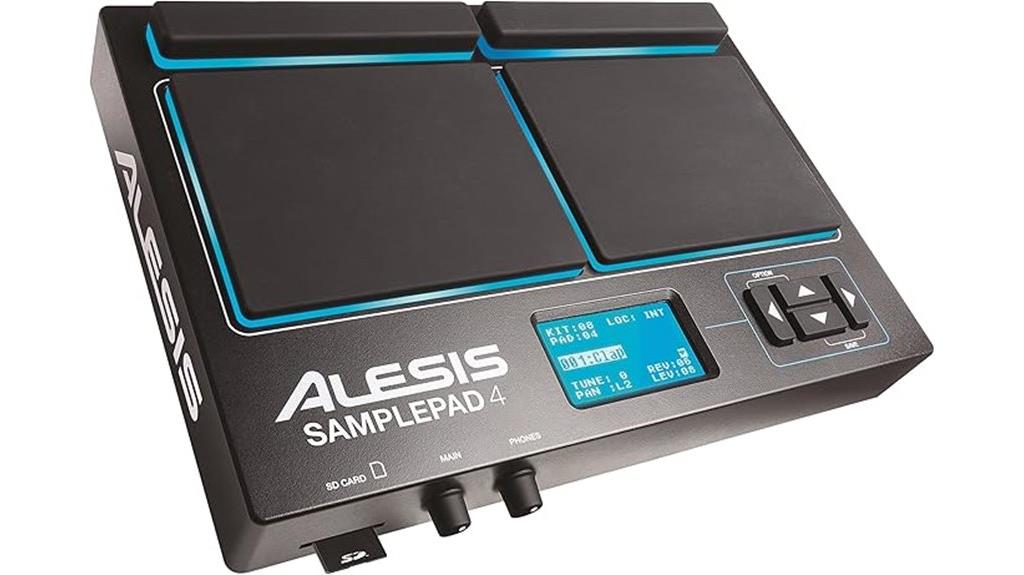
Compact percussion enthusiasts who need maximum portability without sacrificing performance capabilities will find the Alesis Sample Pad 4 delivers exactly what they’re looking for, combining four velocity-sensitive pads with 25 built-in drum sounds in a streamlined package that won’t overwhelm your setup. You’ll appreciate the eight pre-mapped kits that eliminate tedious sound selection, while the dual trigger input expands your creative options beyond the four main pads. The SD/SDHC card slot means you’re not stuck with factory sounds forever, and the MIDI output transforms this compact unit into a versatile controller for external modules and software when your needs evolve.
Best For: Compact percussion enthusiasts who need maximum portability without sacrificing performance capabilities and want a streamlined setup with built-in sounds and expansion options.
Pros:
- Four velocity-sensitive pads with dual trigger input provide excellent performance capabilities in a compact form factor
- Eight pre-mapped kits with 25 built-in sounds offer quick setup and immediate playability
- SD/SDHC card slot and MIDI output provide extensive expansion and connectivity options for future growth
Cons:
- Limited to only four main pads, which may restrict complex playing styles or larger drum arrangements
- Built-in sound library of 25 sounds may feel limited compared to larger drum machines or sample libraries
- Compact size may make the pads smaller than full-size alternatives, potentially affecting playing comfort for some users
Roland TM-2 Acoustic Drum Trigger Module
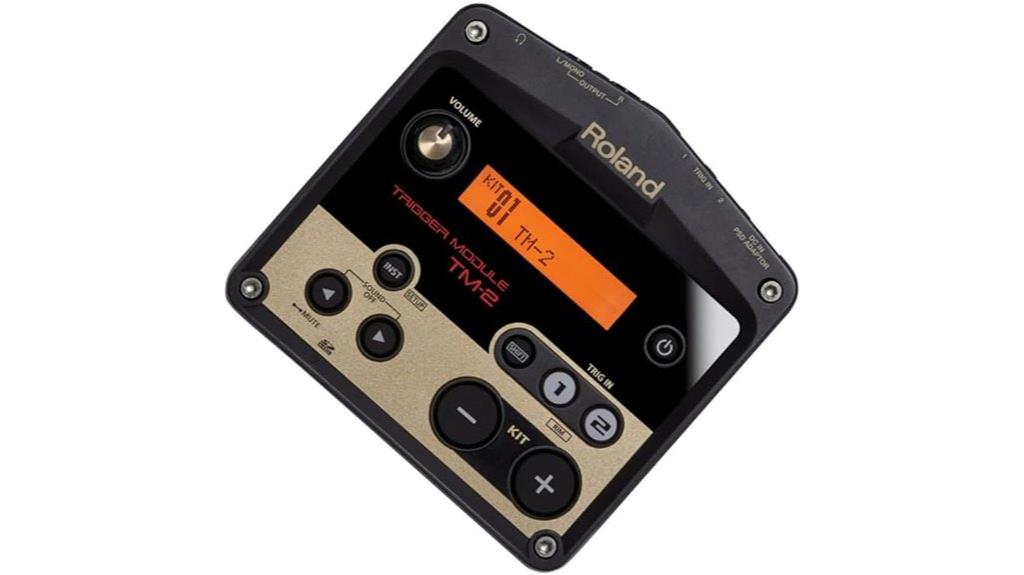
For drummers who’ve grown tired of choosing between acoustic authenticity and digital versatility, Roland’s TM-2 presents a compelling bridge that transforms your traditional kit into something far more capable. This trigger module accepts inputs from Roland pads and acoustic drum triggers, delivering professional-grade sounds that enhance your live performances without compromising the organic feel you’ve spent years perfecting. What sets the TM-2 apart is its practical approach to hybrid drumming, offering ready-to-play sounds that integrate seamlessly with your existing setup while maintaining the affordability that makes experimentation less risky. The SDHC card expansion capability guarantees you won’t outgrow its sonic possibilities quickly.
Best For: Drummers who want to add digital sounds and versatility to their acoustic drum kit for live performances without completely abandoning their traditional setup.
Pros:
- Seamlessly integrates digital sounds with acoustic drums while preserving the organic feel of traditional drumming
- Expandable sound library through SDHC cards ensures long-term versatility and growth potential
- Affordable entry point into hybrid drumming that makes experimentation accessible without major financial commitment
Cons:
- Limited to Roland pads and acoustic drum triggers, which may restrict compatibility with other brand equipment
- May require additional investment in triggers and pads to fully utilize the module’s capabilities
- Sound quality and expansion options are dependent on SDHC card storage rather than built-in extensive sound libraries
Factors to Consider When Choosing Drum Modules
When I’m helping drummers select the right module for their electronic setup, I’ve found that five critical factors consistently determine whether they’ll love their purchase or regret it within months. Sound quality features, including sample depth and trigger responsiveness, work hand-in-hand with connectivity options that determine how well the module integrates with your existing gear, recording software, and performance requirements. I’ll walk you through built-in kit selection variety, recording and MIDI capabilities, plus budget considerations that’ll help you find the sweet spot between features and value.
Sound Quality Features
While many drummers focus on pad responsiveness and build quality when shopping for electronic kits, I’ve found that sound quality remains the single most critical factor that separates mediocre modules from professional-grade instruments. The best modules utilize advanced technologies like Prismatic Sound Modeling and PureAcoustic Ambience Technology, which create remarkably natural-sounding samples that’ll fool even experienced listeners. I particularly value velocity-sensitive pads that capture every nuance of my playing dynamics, translating subtle strikes into authentic tonal variations. Top-tier modules offer extensive sound libraries—some featuring up to 143 instruments—alongside thorough onboard effects including EQ, reverb, and multi-effects processing. The ability to import custom samples elevates these modules further, allowing me to craft personalized soundscapes that perfectly match my musical vision and performance requirements.
Connectivity and Compatibility
Beyond exceptional sound quality, connectivity options determine how effectively your drum module integrates with modern recording workflows, live performance setups, and expanding electronic kit configurations. I prioritize USB connectivity as essential, since it enables seamless audio and MIDI transfer to computers and DAWs without additional interfaces cluttering your workspace. Bluetooth support, while sometimes overlooked, provides wireless convenience for streaming backing tracks or transmitting MIDI data during performances. I’ve found that modules offering multiple TRS outputs excel in multi-channel recording scenarios, allowing individual drum voice isolation. Compatibility matters greatly—ensure your chosen module works with various pad types, acoustic triggers, and expansion components. Mobile app integration adds substantial value, providing sound customization tools and practice features that extend beyond the module’s physical interface limitations.
Built-in Kit Selection
Versatility in built-in kit selection fundamentally shapes your musical expression, as the breadth and quality of preset options determine whether you’ll find sounds that match your creative vision or require extensive customization. I’ve found that modules offering 25 preset and user-configurable kits provide solid starting points for most styles, though you’ll want to take into account the onboard instrument count, which can exceed 143 sounds in premium models. Advanced technologies that replicate acoustic drum behavior greatly enhance sound quality, while built-in effects like EQ, ambience, and multi-effects let you personalize each kit without external processing. The capacity to save 50 to 200 user-created patterns ensures you won’t lose your carefully crafted sounds during performances.
Recording and MIDI
Most drum modules excel at standalone performance, but their recording and MIDI capabilities often determine whether they’ll integrate seamlessly into your home studio workflow or leave you wrestling with compatibility issues. I’ve learned that multi-channel MIDI support is essential for flexible tracking, allowing me to trigger different sounds across various DAW channels without bouncing between menus. USB connectivity simplifies everything, providing direct audio and MIDI transfer that eliminates the cable chaos I once endured. Individual channel recording for each pad transforms post-production mixing, letting me adjust each element independently rather than committing to a fixed balance. Some modules include built-in recording features, though I still prefer routing through my DAW. Advanced sound modeling technologies deliver remarkably natural dynamics that respond authentically to playing nuances.
Budget and Value
When I started shopping for drum modules years ago, I quickly discovered that establishing a realistic budget upfront saves countless hours of frustration and prevents the overwhelming paralysis that comes from browsing endless options across wildly different price ranges. I’ve learned to focus on long-term value rather than just the initial price tag, considering features like sound quality, built-in kit variety, and customization options that’ll keep me satisfied for years. Don’t forget about hidden costs – expansion packs, additional software, and necessary accessories can quickly inflate your total investment. I always check customer reviews to understand real-world performance and common issues, looking for modules that balance essential features with affordability rather than chasing every bells-and-whistles option available.
Physical Design Considerations
After years of hauling drum modules between gigs, home practice sessions, and studio recordings, I’ve developed a keen appreciation for how physical design directly impacts both daily usability and long-term satisfaction with your investment. Compact dimensions and lightweight construction make transportation effortless, while robust materials like reinforced plastics or metal housings withstand the inevitable knocks and drops that come with frequent use. I’ve found that intuitive button layouts and clear LCD displays reduce menu-diving frustration, especially during live performances when quick adjustments are vital. Essential connectivity options, including USB and MIDI ports, guarantee seamless integration with existing setups. Additionally, versatile mounting compatibility with standard stands and rack systems provides setup flexibility that accommodates everything from cramped bedroom corners to expansive studio configurations.
On a final note
I’ve tested countless drum modules over the years, and these eight represent the cream of the crop for different budgets and applications. Whether you’re tracking in a professional studio, practicing quietly at home, or performing live gigs, there’s a module here that’ll deliver the sound quality and features you need. Don’t overthink it – pick the one that matches your specific requirements and start making music.

